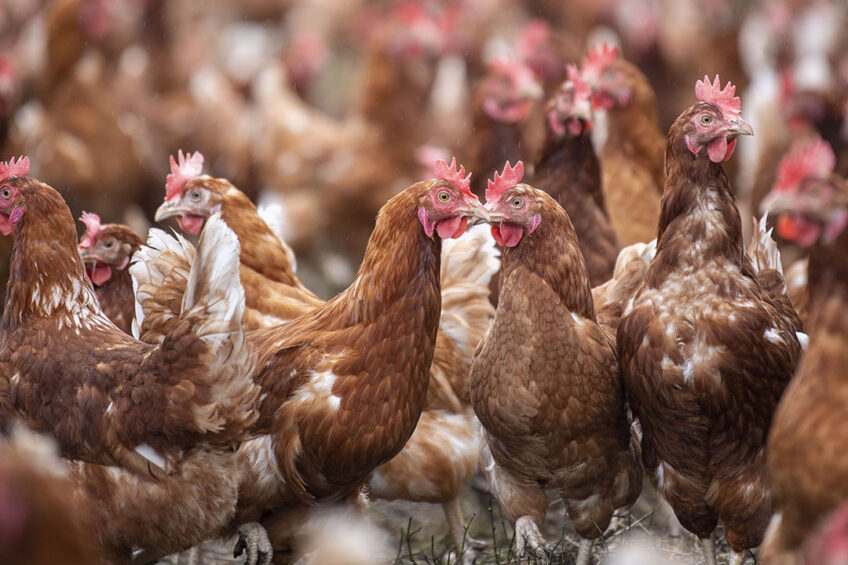Improving layer hen welfare with better keel bone health

Keel bone damage, deviations, or fractures in a bird’s breastbone, is an ongoing and prevalent problem among conventional laying hens and can be linked to the number and quality of eggs produced.
It is recognised as being a multifactor problem attributed to a combination of housing design, genetics, feed and nutrition, behaviour, rearing practices and other issues. And with a growing numbers of birds moving to cage-free housing by 2025 – up to 225 million alone in the US – there is a growing clamour for additional research.
The Foundation for Food and Agriculture Research (FFAR) and Open Philanthropy created the Laying Hen Keel Bone Health Programme to provide funds to support global, cross-disciplinary teams that use evidence-based approaches to measurably reduce the incidence of keel bone damage. It is awarding 2 grants, totalling just under US$3 million to researchers at The University of Edinburgh and University of California, Davis. Several matching funders, including Hy-Line International, have provided support of an investment of nearly US$7 million.
Digital x-rays and conventional imaging techniques
The grant is the second significant funding in this area in the past 5 years. The first grant enabled researchers at The Roslin Institute at the University of Edinburgh has looked at how radiography can measure bone quality in live birds to help inform selection of laying hens. Scientists, led by Professor Ian Dunn, have developed a reliable digital x-ray procedure that takes around 45 seconds to conduct, making it practical for both hens and poultry workers.
The procedure offers a fast, practical alternative to conventional imaging techniques such as Dual-Energy X-ray Absorptiometry, Digitised Fluoroscopy and CT scans. This latest grant is enabling the team to examine if breeding programmes for improve keel health needs to vary depending on poultry housing design.
Puberty, bone quality and breeding
Prior research highlighted the role of age at puberty on bone strength. The consortium’s work is further exploring this relationship by manipulating diet and light to delay puberty and measuring the resulting effects on bone quality. They are also determining whether a diet that produces lower homocysteine, an amino acid, increases collagen strength and improves keel quality.
Professor Dunn: “For many decades, poultry breeders have chosen which birds to breed according to a mix of many factors, but it has not been possible to account for bone quality in live hens, and a practical method of measuring bone quality in hens has been unavailable. Our method represents a major development to aid selection towards improving bone strength, and health and welfare, in laying hens.
“This project seeks to enable genetic selection directly for the keel bone itself, as well as novel nutritional approaches and the influence of the timing of when hens start to lay eggs on their bone quality,” he added.
Housing and genetics
The US research, led by Dr Huaijun Zhou, is aiming to decrease the occurrence of keel bone damage by examining the birds’ housing environments and assessing the key relation and role of genetics. They are identifying genetic markers associated with keel bone damage in breeding flocks raised under different housing environments and improving genetic selection to promote resistance to keel bone fractures.
They are also evaluating the effects of housing design interventions on the development, type and prevalence of keel bone damage as well as exploring alternative housing designs and conducting economic analyses to determine the costs and gains from the proposed adjustments to breeding and housing designs.
“Like many other economically important traits in poultry, keel bone damage is a complex issue affected by genetic and environmental factors, such as type of housing systems,” said Zhou, principal investigator for the UC Davis research and a professor of animal science in the College of Agricultural and Environmental Sciences.
Early detection
Dr Danny Lubritz, Hy-Line International’s director of research and development, said the research should deliver tools for the early detection and genetic improvement of keel bone health in cage and cage free settings: “Hy-Line International can integrate this information into its genomic programme to simultaneously improve egg production, egg quality and bird welfare,” he added.
Nikki Dutta, FFAR scientific programme officer, said: “Improving the welfare of animals is a critical component of animal husbandry, and keel bone damage is a serious threat to the wellbeing of layer hens. These research projects are helping ensure humane treatment and a better quality of life for the animals that meet our food and nutrition needs.”












